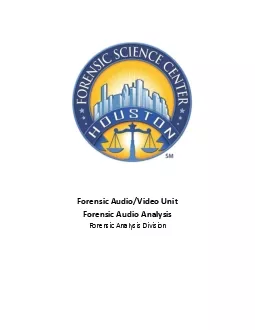

Forensic Audio AnalysisForensic Analysis DivisionForensic AudioVideo UnitForensic Audio AnalysisForensic Analysis DivisionForensic Audio AnalysisFADFAVUSOP5Issued By Section SupervisorIssue Date Ja ID: 873282
Download Pdf The PPT/PDF document "Forensic AudioVideo Unit" is the property of its rightful owner. Permission is granted to download and print the materials on this web site for personal, non-commercial use only, and to display it on your personal computer provided you do not modify the materials and that you retain all copyright notices contained in the materials. By downloading content from our website, you accept the terms of this agreement.
1 Forensic Audio/Video Unit Forensic Aud
Forensic Audio/Video Unit Forensic Audio Analysis Forensic Analysis Division Forensic Audio/Video Unit Forensic Audio Analysis Forensic Analysis Division Forensic Audio Analysis FAD - FAVU - SOP5 Issued By: Section Supervisor Issue Date: January 11 , 2016 Uncontrolled When Printed Page 2 of 3 1. Forensic Audio Analysis 1.1. Scope 1.1.1. This procedure applies to Forensic Audio/Video Unit analysts whose primary responsibility is to analyze and examine audio evidence. 1.2. Limitations 1.2.1. Using the wrong type of filters or not properly configuring filter settings could negatively affect the intelligibility of voice content. 1.3. Recommended Equipment /Software : Computer/Laptop – CD/DVD writer, admin istrative access, USB/Network/Firewire ports, etc. Headphones Appropriate software Camera (if needed) Cables/Wires (as needed) Izotope RX Sound Forge Pro Adobe Audition Audacity Cardinal MiniLab 1.4. Procedure 1.4.1. Inspect submitted items for physical damage (this includes cassette housings, magnetic tape, CD s). If irregularities are found, document the condition of media received in the case record and/or report . 1.4.2. D escribe and document the items received (e.g. type of media, manufacturer information, write protection, previous markings). 1.4.3. I
2 f possible, digital evidence should be
f possible, digital evidence should be scanned for viruses before any files are opened. 1.4.4. To preserve the integrity of a digital original, make a bit stream duplicate to use as a wo rking copy. 1.4.5. Determine any file information (i.e. codecs). R efer to FAD - FAVU - SOP2 Media File Analysis for proper procedures. 1.4.6. Converting the audio file(s) may be necessary. Convert to or between uncompressed formats (e.g., PCM) whenever possible. 1.4.7. If analyz ing analog evidence, determine the proper equipment for play back. C apture the analog signal to an uncompressed digital format. Use this digital copy as the working copy for further examinations. 1.5. Audio Enhancement Procedure 1.5.1. Determine the proper type of audio device and connections to accurately playback the original audio recording. 1.5.1.1. Audio media such as cassette tape (standard, micro, or mini) may require an azimuth adjustment to optimize the frequency response of the audio content. Forensic Audio/Video Unit Forensic Audio Analysis Forensic Analysis Division Forensic Audio Analysis FAD - FAVU - SOP5 Issued By: Section Supervisor Issue Date: January 11 , 2016 Uncontrolled When Printed Page 3 of 3 1.5.1.2. V e rify that the audio playback device is working properly. 1.5.2. Playback the entire audio recording to analyze and determine the types of noise issues with the recording.
3 1.5.3. Select the audio filter(s) t
1.5.3. Select the audio filter(s) that will effectively reduce noise and clarify speech content. It may be necessary to apply different types of filtering techniques to maximize audio clarity. Examples of audio filters include (but are not limited to): Graphic Equalizer, High/Low Pass filter, Notch filter, Comb filter, and Adaptive filter. 1.5.4. Document t he selected filter(s) and filter settings electronically or in the case notes (e.g. using screenshots or an audit trail in the software ) . 1.5.5. Once the analyst has determined the most effective filters to clarify the audio content, apply them to the entire au dio recording or pertinent area(s ) requested by the customer . 1.5.6. If recording to analog media, start the recording of the blank media first and then start playback of the original audio recording to ensure that all of the pertinent speech is captured. 1.5.7. Verify that the enhanced copy recorded properly by playing back the audio media. 1.5.8. Mark the enhanced audio copies with the forensic case number, unique identifier and the analyst ’s initials. 1.5.9. All original items and derivatives made are returned to the customer. 1.6. Ref erences Scientific Working Group on Digital Evidence – www.swgde.org Scientific Working Group on Imaging Technology – www.swgit.org Law Enforcement and Emergency Services Video Association International – www.leva.org